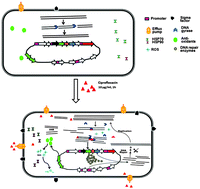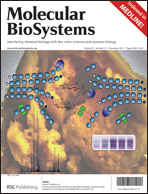Transcriptomic study of ciprofloxacin resistance in Streptomyces coelicolor A3(2)†
Abstract
Soil organisms exhibit resistance to a wide range of antibiotics as they either need to protect themselves from endogenous antibiotics or from those present in their soil environment. The soil could serve as a reservoir for resistance mechanisms that have already emerged or have the potential to emerge in clinically important bacteria. Streptomyces coelicolor, a non-pathogenic soil-dwelling organism, is thus used as a model for the study of intrinsic resistance. Preliminary screening of several compounds showed that S. coelicolor had high intrinsic resistance for the fluoroquinolone group of antibiotics. We subjected the bacteria to sub-inhibitory concentrations of ciprofloxacin and studied the transcriptomic response using microarrays. The data were supported with various biochemical and phenotypic assays. Ciprofloxacin treatment leads to differential expression of many genes with enhanced mRNA expression of its target, DNA gyrase gene. High induction of DNA repair pathways was also observed and many transporters were upregulated. Ciprofloxacin was found to induce ROS formation in a dose dependent manner. Reduction of ROS via anti-oxidants increased the effective MIC of the drug in the bacteria. The regulation of antibiotic resistance in S. coelicolor was studied systematically and contribution of different mechanisms in the development of resistance was assessed. Our data suggest that multiple mechanisms work in coordination to facilitate the cell to combat the stress due to ciprofloxacin.


 Please wait while we load your content...
Please wait while we load your content...